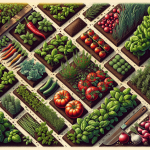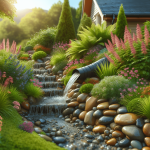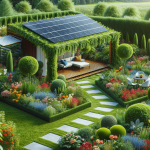This post may contain affiliate links. As an Amazon Associate, we may earn commissions from qualifying purchases.
How can you create a themed garden, such as a Japanese or Mediterranean garden? This might sound like an overwhelming task, but don’t worry; with the right steps and a bit of creativity, you can transform your backyard into a tranquil Japanese sanctuary or a sun-soaked Mediterranean oasis. Let’s embark on this garden makeover journey together!
Understanding Your Garden Theme
Before you start digging and planting, it’s crucial to understand what makes a garden a “Japanese” or “Mediterranean” garden. Each theme has unique characteristics that will guide your selections and design decisions.
Japanese Garden Characteristics
Japanese gardens are designed to create peace and tranquility. They often feature elements like water, rocks, and plants chosen for their beauty and simplicity. Here are some of the primary features you might incorporate:
- Water Elements – Ponds, streams, and waterfalls.
- Plants – Bonsai trees, maple trees, bamboo, and moss.
- Seating Areas – Simple wooden benches or stone seats.
- Decorative Elements – Stone lanterns, bridges, and pagodas.
Mediterranean Garden Characteristics
Mediterranean gardens are inspired by the warm, dry climates of southern Europe. They emphasize bold colors, fragrant plants, and outdoor living spaces. Key elements often include:
- Water Elements – Fountains and reflecting pools.
- Plants – Olive trees, lavender, rosemary, and citrus trees.
- Seating Areas – Wrought iron or wooden furniture.
- Decorative Elements – Terra cotta pots, mosaic tiles, and pergolas.
Planning Your Themed Garden
The first step in creating your themed garden is meticulous planning. A well-thought-out plan will save you time and money in the long run.
Assess Your Space
Take a good look at your garden space. Measure its dimensions and note any specific characteristics such as slopes, existing plants, or structures. This will help you understand what you have to work with.
Create a Garden Layout
Sketch a rough layout of your garden. Don’t worry; you don’t need to be an artist. The sketch will help you visualize where different elements will go. Include pathways, seating areas, water features, and plant zones in your drawing.
Consider Your Climate
Both Japanese and Mediterranean plants are specific to certain climates. Ensure you choose plants that will thrive in your local environment. For example, Mediterranean plants are often drought-resistant, perfect for dry, sunny climates, while Japanese garden plants might require more moisture and shade.
Budgeting
Creating a themed garden doesn’t have to break the bank. Decide on a budget and prioritize the elements that are most important to you. Some aspects, like certain types of plants or stone features, might be more expensive, so plan accordingly.
Choosing Your Plants
Japanese Garden Plants
Here’s a list of common plants you might consider for a Japanese garden, along with some basic care tips:
| Plant | Characteristics | Care Tips |
|---|---|---|
| Bonsai Trees | Miniature trees, usually in pots | Requires regular pruning and special soil |
| Maple Trees | Vibrant autumn colors | Partial shade, well-drained soil |
| Bamboo | Tall, fast-growing | Needs containment; can spread aggressively |
| Moss | Soft, green carpet | Likes shade and moisture |
Mediterranean Garden Plants
For a Mediterranean garden, you might choose from the following:
| Plant | Characteristics | Care Tips |
|---|---|---|
| Olive Trees | Iconic tree with silver-green leaves | Needs full sun and well-drained soil |
| Lavender | Fragrant purple flowers | Full sun, drought-tolerant |
| Rosemary | Fragrant herb, small blue flowers | Full sun, drought-tolerant |
| Citrus Trees | Orange, lemon, or lime trees | Needs sun, regular watering in pots |
Incorporating Water Features
Water features add elegance and tranquility to your garden. Here’s how you can integrate them into your themed garden.
Japanese Garden Water Features
In a Japanese garden, water features like ponds, waterfalls, and streams are essential. They represent the natural beauty of water and often serve as focal points.
Building a Pond
- Choose Location: Pick a spot that gets some sunlight but also has shaded areas.
- Excavate: Dig a hole and line it with a pond liner.
- Install a Pump: This keeps the water clean and adds movement.
- Add Plants and Fish: Lotus plants and koi fish are popular choices.
Small Waterfall or Stream
If space is limited:
- Stack Rocks: Create a natural waterfall effect by stacking large rocks.
- Install a Pump: Ensure there’s movement in the water for a soothing sound.
- Add Greenery: Use moss and small plants around the rocks for a natural look.
Mediterranean Garden Water Features
Mediterranean gardens often feature smaller, more contained water elements like fountains or small reflecting pools.
Installing a Fountain
- Choose a Style: Traditional stone or terra cotta fountains work best.
- Pick a Location: Near a seating area or as a focal point.
- Install a Pump: This keeps the water circulating.
- Decorate: Surround the fountain with potted plants or mosaic tiles for added charm.
Reflecting Pool
- Choose Location: Pick a sunny spot.
- Excavate and Line: Use a liner to prevent water seepage.
- Add Elements: Incorporate floating plants or tiles to enhance the effect.
Creating Seating Areas
Japanese Garden Seating
Seating in a Japanese garden is often understated but strategically placed to reflect and enjoy the view.
Simple Wooden Benches
- Location: Near water features or under a tree.
- Style: Natural wood, often unpainted.
- Accessories: Add cushions or mats for comfort.
Stone Seats
- Integrate with Nature: Place on top of flat rocks or boulders.
- View: Ensure they face garden focal points.
Mediterranean Garden Seating
Outdoor living is central to Mediterranean gardens. Seating areas are often lively and inviting.
Wrought Iron Furniture
- Style: Choose intricate designs.
- Comfort: Add colorful cushions and throws.
- Placement: Near plants for shade and fragrance.
Wooden Furniture
- Durability: Choose weather-resistant wood.
- Accents: Terra cotta pots and mosaic tables enhance the theme.
- Placement: Under pergolas or beside water features.
Adding Decorative Elements
Japanese Garden Decor
Japanese garden decor is simple yet meaningful. Each element represents balance, nature, and tranquility.
Stone Lanterns
- Placement: Near pathways or water features.
- Material: Choose natural stone for authenticity.
- Lighting: Consider adding LED lights for a subtle glow.
Bridges
- Size: Small bridges work best.
- Location: Over ponds or dry river beds.
- Material: Natural wood or stone.
Mediterranean Garden Decor
Decor in a Mediterranean garden is vibrant and earthy. It draws from the sun-drenched colors and textures of southern Europe.
Terra Cotta Pots
- Variety: Use different sizes and shapes.
- Plants: Fill with herbs, flowers, or small trees.
- Placement: Clustered around seating areas or pathways.
Mosaic Tiles
- Colors: Bold, bright colors are key.
- Uses: Customize steps, tables, or garden walls.
- Patterns: Geometric designs or floral motifs work well.
Pathways and Structures
Japanese Garden Pathways
Pathways guide visitors through a Japanese garden, offering different perspectives of its beauty.
Stepping Stones
- Natural Shapes: Use irregular, flat stones.
- Spacing: Leave space for stepping.
- Surroundings: Line with moss or low-growing plants.
Gravel Paths
- Material: Use fine gravel, often raked into patterns.
- Edging: Use stones or wooden borders.
- Design: Create meandering paths through the garden.
Mediterranean Garden Pathways
Pathways in a Mediterranean garden are practical yet beautiful, often bordered with colorful plants.
Stone Pavers
- Material: Natural stone or terra cotta.
- Pattern: Simple or intricate designs.
- Borders: Line with lavender, rosemary, or other aromatic plants.
Gravel Paths
- Material: Coarse gravel.
- Edging: Use bricks or stones.
- Accents: Add stepping stones or tiles for interest.
Structures
Both garden styles incorporate structures to enhance the design and provide functionality.
Japanese Pergolas
- Material: Wood, often painted or stained.
- Use: Provide shade and structure for seating areas.
- Design: Simple, with clean lines and minimal decoration.
Mediterranean Pergolas
- Material: Wood or wrought iron.
- Use: Shade for seating or dining areas.
- Design: Often ornate, with climbing plants like bougainvillea or grapevines.
Maintenance Tips
Japanese Garden Maintenance
Maintaining a Japanese garden involves regular care to keep it tidy and harmonious.
- Pruning: Regularly prune bonsai trees and bushes to maintain shapes.
- Watering: Ensure water features are clean and free from debris.
- Weeding: Keep pathways and moss areas free from weeds.
- Seasonal Care: Adjust care routines according to the season. For instance, protect delicate plants from frost.
Mediterranean Garden Maintenance
Mediterranean gardens are relatively low-maintenance but still need care to stay vibrant.
- Pruning: Trim herbs and bushes regularly.
- Watering: Even drought-tolerant plants need water, especially during dry spells.
- Cleaning: Remove any fallen leaves from pathways and seating areas.
- Soil Care: Mulch and fertilize as needed to maintain healthy soil.
Final Thoughts
Creating a themed garden like a Japanese or Mediterranean garden is a rewarding project that transforms your outdoor space into a personal retreat. By understanding the key characteristics of each style, planning carefully, selecting the right plants and features, and dedicating some time to maintenance, you can achieve a beautiful and serene garden that reflects your taste and provides a perfect escape from daily stress.
So, roll up your sleeves, draw your plans, and get started. Your dream garden awaits!








